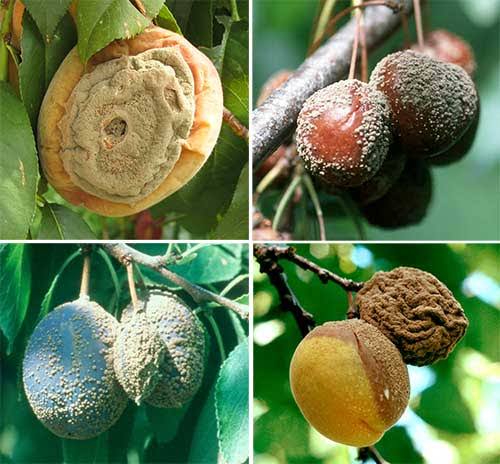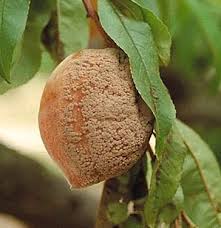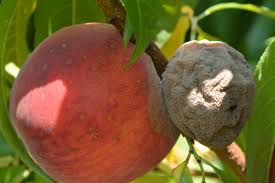Brown rot (stone fruit disease) is a common and destructive fungal infection affecting stone fruit trees, including peaches, plums, cherries, and apricots. Scientifically known as Monilinia fructicola, this pathogen poses a significant threat to orchards worldwide.
The fungus primarily targets ripe fruits, causing a rapid decay characterized by brown, velvety lesions. This infectious menace thrives in warm, humid conditions, making it particularly problematic in regions with favorable climates. The fungus can strike during both pre- and post-harvest periods, leading to substantial economic losses for fruit growers.
Infection typically begins with spores landing on the fruit surface, often facilitated by rain, wind, or insects. Once settled, the fungus quickly infiltrates the fruit’s delicate tissues, initiating a cascade of biochemical reactions that culminate in the characteristic symptoms of brown rot.
The initial signs are subtle, with small, water-soaked spots appearing on the fruit. As the infection progresses, these spots enlarge and become covered in brown spore masses, giving the disease its name. The fungus efficiently spreads from one fruit to another, creating a domino effect that can devastate entire orchards if left unchecked.
Integrated pest management strategies are crucial for controlling brown rot. These may include cultural practices, such as pruning to improve air circulation, and timely harvesting to reduce the risk of infection. Fungicides are also commonly employed, though their effectiveness may vary, and their use should be carefully managed to prevent the development of resistance.
Beyond its economic impact, brown rot poses challenges for sustainable agriculture and food security. The loss of marketable fruit not only affects the livelihoods of farmers but also reduces the availability of fresh produce for consumers.
However, Monilinia fructicola, commonly known as brown rot, stands as a formidable adversary for stone fruit growers. Vigilant management practices, combined with ongoing research into disease-resistant varieties, offer hope for mitigating the impact of this fungal threat and ensuring the continued abundance of delicious stone fruits for generations to come.
Read Also: The Importance and Uses of Hay
Plants Affected by Brown Rot (Monilinia fructicola)

Brown rot (stone fruit disease) affects a variety of fruit-bearing plants, commonly known as stone fruits. These include peaches, plums, cherries, and apricots. The disease targets the fruits of these plants, leading to significant economic losses for farmers and impacting the availability of fresh produce in the market. The scientific name for the pathogen causing brown rot is Monilinia fructicola.
The insidious nature of brown rot makes it a particularly challenging adversary for stone fruit growers. Among the affected plants, peaches (Prunus persica) are especially susceptible to this fungal menace. The succulent and delicate nature of peaches, coupled with their popularity among consumers, magnifies the economic consequences of brown rot outbreaks in peach orchards.
Plums (Prunus domestica) also fall prey to brown rot, with the disease causing premature spoilage of these delectable fruits. The ability of the fungus to rapidly spread among plum trees further exacerbates the impact, requiring vigilant orchard management to mitigate losses.
Cherries (Prunus avium and Prunus cerasus) share a vulnerability to brown rot, putting these vibrant and flavorful fruits at risk. The infectious nature of the fungus can result in widespread damage to cherry crops, affecting both sweet and sour varieties.
Apricots (Prunus armeniaca) complete the roster of stone fruits susceptible to brown rot. The velvety skin and juicy flesh of apricots provide an ideal environment for the fungus to thrive, leading to the characteristic brown lesions that signify infection.
The widespread impact of brown rot on these stone fruit varieties underscores the importance of comprehensive disease management strategies. Farmers must employ a combination of cultural practices, such as proper pruning and harvesting, along with judicious use of fungicides to curb the spread of Monilinia fructicola and safeguard their orchards.
However, brown rot poses a serious threat to an array of stone fruit plants, including peaches, plums, cherries, and apricots. Understanding the susceptibility of these fruits to Monilinia fructicola is crucial for implementing effective measures to control the disease and preserve the economic viability of stone fruit cultivation.
Damages Caused by Brown Rot (Monilinia fructicola)

Brown rot (stone fruit disease) inflicts substantial damages on stone fruit crops, impacting both the quantity and quality of the harvest. The consequences of Monilinia fructicola’s attack on susceptible plants are varied and detrimental to the economic viability of orchards.
1. Fruit Decay: The most conspicuous damage caused by brown rot is the rapid decay of affected fruits. Infected fruits develop brown, velvety lesions that spread quickly, rendering them unsuitable for consumption. This decay not only reduces the marketable yield but also results in significant economic losses for farmers.
2. Reduced Market Value: Fruits affected by brown rot are aesthetically unappealing and often unsuitable for sale in fresh produce markets. The reduced market value of infected fruits further exacerbates the financial impact on growers, as consumers tend to avoid purchasing blemished or decaying produce.
3. Preharvest Losses: Brown rot can strike fruit crops both before and after harvest. Preharvest losses occur when the fungus infects the fruits while still on the tree, leading to premature spoilage and a decrease in the overall yield of the orchard. This aspect of the damage is particularly challenging for farmers, as it affects the potential revenue from their harvest.
4. Postharvest Deterioration: Even after harvest, fruits can succumb to brown rot during transportation, storage, or on display. The fungus remains active, causing further deterioration of fruits even after they have been removed from the orchard. This postharvest damage contributes to additional losses in the supply chain.
5. Impact on Fruit Quality: Beyond quantity, brown rot compromises the quality of stone fruits. The fungus can affect the taste, texture, and overall desirability of the infected fruits. This has implications for consumer satisfaction and trust in the reliability of stone fruit products.
6. Risk of Spreading: Brown rot is highly contagious, with the potential to spread rapidly through an orchard or between neighboring orchards. The ease of transmission poses a continuous threat to the health of stone fruit crops and requires proactive measures to contain and manage the disease effectively.
The damages caused by brown rot extend beyond the visible decay of fruits, they encompass economic losses, diminished market value, pre- and postharvest deterioration, and a pervasive impact on fruit quality. To address these challenges, stone fruit growers must implement robust disease management strategies to mitigate the detrimental effects of Monilinia fructicola on their orchards.
Read Also: Grasshoppers: Description, Damages Caused, Control and Preventive Measures
Control and Preventive Measures

Controlling and preventing brown rot (stone fruit disease) requires a multifaceted approach that combines cultural practices, chemical interventions, and vigilant orchard management. Here are key measures to mitigate the impact of Monilinia fructicola:
1. Pruning and Thinning: Regular pruning enhances air circulation within the tree canopy, reducing humidity and creating an environment less favorable for the fungus. Thinning fruit clusters also helps minimize overcrowding, limiting the potential for spore transmission.
2. Timely Harvesting: Harvesting fruits at the right maturity stage reduces their susceptibility to brown rot. Picking fruits promptly helps prevent the spread of the disease from overripe or damaged fruits to healthier ones.
3. Sanitation Practices: Proper disposal of infected fruits and debris from the orchard is crucial to interrupt the disease cycle. Removing fallen fruits and pruning residues minimizes the presence of inoculum and prevents the fungus from overwintering.
4. Fungicide Applications: Application of fungicides is a common strategy to control brown rot. Fungicides should be applied according to a carefully planned schedule, especially during critical periods such as bloom and preharvest. However, their use should be judicious to prevent the development of resistance.
5. Cultural Practices: Implementing good agricultural practices, such as avoiding excessive irrigation and maintaining proper spacing between trees, contributes to an environment less conducive to brown rot development. These practices reduce the duration of leaf wetness and minimize the risk of infection.
6. Monitoring and Early Detection: Regular scouting for symptoms of brown rot allows for early detection. By identifying infected fruits promptly, growers can take immediate action to minimize the spread of the disease through targeted interventions.
7. Resistant Varieties: Research and adoption of brown rot-resistant stone fruit varieties offer a sustainable long-term solution. Breeding programs aim to develop cultivars with increased resistance to Monilinia fructicola, reducing the reliance on chemical controls.
8. Weather Monitoring: Given the preference of brown rot for warm and humid conditions, monitoring weather patterns is essential. Timely and accurate weather information enables growers to anticipate conditions favorable for disease development and adjust their management strategies accordingly.
9. Integrated Pest Management (IPM): Adopting an integrated approach that combines various control methods is crucial. IPM incorporates cultural, biological, and chemical measures, aiming for a balanced and sustainable strategy to manage brown rot and other pests.
By combining these measures, stone fruit growers can enhance their ability to control and prevent brown rot outbreaks, safeguarding their crops and ensuring a more sustainable and economically viable orchard management system.
Frequently Asked Questions (FAQs) About Brown Rot (Monilinia fructicola)
Q1: What is brown rot, and which fruits does it affect?
A: Brown rot is a fungal disease caused by Monilinia fructicola, affecting various stone fruits. Commonly affected fruits include peaches, plums, cherries, and apricots.
Q2: How does brown rot spread?
A: Brown rot spreads through spores produced on infected fruits. Rain, wind, and insects can facilitate the dispersal of spores to healthy fruits, initiating new infections.
Q3: What are the visible symptoms of brown rot?
A: Brown rot symptoms include small, water-soaked spots on fruits that develop into brown, velvety lesions. Infected fruits decay rapidly, leading to a characteristic brown appearance.
Q4: When is the peak season for brown rot infections?
A: The peak season for brown rot infections typically occurs during warm and humid weather conditions, especially during the flowering and ripening stages of stone fruits.
Q5: How can farmers prevent brown rot in orchards?
A: Preventive measures include timely harvesting, proper pruning for air circulation, sanitation practices, fungicide applications, and the use of resistant fruit varieties.
Q6: Can brown rot be controlled without using chemical fungicides?
A: Yes, cultural practices like pruning, thinning, and sanitation, along with the use of resistant varieties, can contribute to brown rot control. However, in severe cases, fungicides may be necessary.
Q7: What is the economic impact of brown rot on fruit growers?
A: Brown rot can lead to significant economic losses due to reduced marketable yield, decreased fruit quality, and the need for costly disease management strategies.
Q8: How does weather influence brown rot development?
A: Warm and humid conditions favor the development of brown rot. Monitoring weather patterns is crucial for anticipating favorable conditions and adjusting management practices accordingly.
Q9: Are there organic methods to control brown rot?
A: Organic methods include cultural practices, like sanitation and the use of resistant varieties, along with biofungicides. However, organic control may require a more comprehensive approach.
Q10: Can brown rot be transmitted to other types of plants?
A: Brown rot primarily affects stone fruit trees, but it is not known to infect other types of plants. The fungus has a specific affinity for the Prunus genus, which includes stone fruits.
